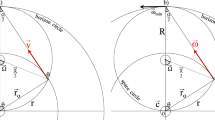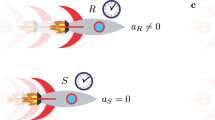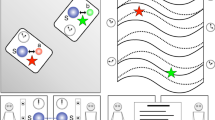Abstract
IT would be inappropriate to give here an additional derivation of the asymmetrical relative ageing of twin brothers predicted by relativity theory for the familiar round trip. In his first paper on relativity, A. Einstein derives the well-known result1; he does not, as claimed by Prof. H. Dingle, make a “regrettable error”2. The recent derivation by W. H. McCrea3 emphasizes that the Lorentz transformation of special relativity is sufficient to describe the round trip from the point of view of either twin, provided that one retains the usual central role assigned by Einstein to “a system of co-ordinates in which the equations of Newtonian mechanics hold good (that is, to the first approximation)”4.
This is a preview of subscription content, access via your institution
Access options
Subscribe to this journal
Receive 51 print issues and online access
$199.00 per year
only $3.90 per issue
Buy this article
- Purchase on Springer Link
- Instant access to full article PDF
Prices may be subject to local taxes which are calculated during checkout
Similar content being viewed by others
References
Einstein, A., Ann. Physik., 17, 891 (1905). See sec. 4. All the publications of Albert Einstein to which I refer in this article are found in English translation in the recently republished book by H. Lorentz, A. Einstein, H. Minkowski and H. Weyl, “The Principle of Relativity” (Dover Publications, Inc.).
Dingle, H., Nature, 177, 782 (1956).
McCrea, W. H., Nature, 167, 680 (1951).
Einstein, A., Ann. Physik, 17, 891 (1905), see sec. 1, first sentence.
Dingle, H. ; McCrea, W. H., Nature, 178, 680, 681 (1956). Dingle, H., Nature, 179, 865 (1957).
Dingle, H., Proc. Phys. Soc., A, 69, 925 (1956).
Einstein, A., Ann. Physik, 17, 891 (1905), see last half of sec. 1.
Møller, C., “The Theory of Relativity” (Oxf. Univ. Press, London, 1952).
Einstein, A., Ann. Physik, 49, 769 (1916), see sec. 2.
Einstein, A., Ann. Physik, 49, 769 (1916), see sec. 1, first paragraph.
Author information
Authors and Affiliations
Rights and permissions
About this article
Cite this article
CRAWFORD, F. The ‘Clock Paradox’ of Relativity. Nature 179, 1071–1072 (1957). https://doi.org/10.1038/1791071a0
Issue Date:
DOI: https://doi.org/10.1038/1791071a0
This article is cited by
-
Relativistic observations and the clock problem
Il Nuovo Cimento (1960)
-
The ‘Clock Paradox’ of Relativity
Nature (1957)
Comments
By submitting a comment you agree to abide by our Terms and Community Guidelines. If you find something abusive or that does not comply with our terms or guidelines please flag it as inappropriate.



